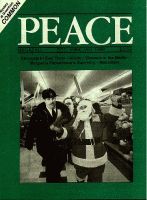
Peace Magazine Dec 1989-Jan 1990, page 10. Some rights reserved.
Search for other articles by Shirley Farlinger here
Kim Besley and Peg Ridge are in Canada to alert us to the dangers of electromagnetic waves in our electrical systems and everyday appliances. Our hydroelectric towers, underground lines, and visual display terminals on our computers could be causing subtle but dire damage to human health. They're having trouble getting their message across.
It takes a special kind of courage to stand up to conventional scientific wisdom and the giant Ontario Hydro with its soothing studies. They have that kind of courage: They come from Greenham Common.
Kim Besley: The Greenham Common peace camp began in 1981 with 40 women. We camped out in all weather at the eight gates leading into the NATO base near Newbury, U.K. We were protesting, as you know, the use of a "common" for military purposes. The base started as a landing strip but later cruise missiles were brought in and a cement silo built to store the nuclear warheads. In December, 1982, we had 30,000 women completely surround the base outside the nine-mile fence. This attracted a lot of attention. We went over the fence and danced on the silos. A force of 2,000 police per day was stationed from then on at Greenham to keep us out. Then in the summer of 1984, the police and the row of British army personnel left the fence.
Shirley Farlinger: You must have wondered what was happening there.
Besley: Yes, we did. From then on, the women started experiencing odd health effects - swollen tongues, changed heartbeats, immobility, feelings of terror, pains in the upper body. My thirty-year-old daughter was so ill she couldn't stand up. Her menstrual cycle changed to 14 days and took a year to return to normal. This occurred even after a short visit near the gates.
Farlinger: Why were you picked to investigate this?
Besley: I was a World War II radio engineer and radar operator and we thought we must be suffering from some sort of waves directed at us. I formed a research committee. It wasn't until we looked at behavioral science research that we hit the jackpot. All secret services have been fascinated with controlling people and the U.S. Freedom of Information Act helped us. Scientists and doctors had not helped.
Farlinger: Why don't the scientists believe you?
Besley: The effects are so varied. We have even taken pictures of the readings on our electromagnetic detector to show them, but they put the effects down to women's hysteria and stress. We found studies though in mice where in three generations they are one-half their normal size. It's the non-ionizing low frequency waves which seem to damage the cells. About 15 percent of American males are sterile and we will see a gradual debilitation of the immune system, causing health problems.
Farlinger: Many people even in the peace movement think that the Greenham women have been driven away. What is going on right now?
Peg Ridge: We still have the camps but now the women are not allowed to build shelters or have fires, although the police can. We have a network of people who bring at least one hot meal to the campers every day. In addition, we still have cruisewatch. We have stopped all sixty of these midnight forays over the past five years. The idea was to practice the deployment of the cruise missiles on English country roads where the U.S. military thought they could "melt into the countryside." Imagine four 20-foot launchers, two control unit trucks, two wreckers for repairs, interspersed with police cars with searchlights blazing, trying to melt into the countryside. It's terrifying, yet so funny.
Our network is notified by phone when the first vehicle leaves the gate. Women grab their gear and flashlights and drive to a spot where they can stop the procession. It sometimes halts on the narrow roads. We put up banners, throw eggs, and paint peace signs on the windshields. We use a Greenham goo made of porridge and dye. All our actions are nonviolent.
The women are arrested, given fines (which they refuse to pay) and jailed for about a week. A new tactic now allows bailiffs to seize their furniture and sell it at auction. Friends try to buy it back. It's a game and after five years, both sides are getting more creative.
Farlinger: Have some of the missiles been removed?
Besley: Yes, 48 have gone but 48 remain until 1991, under the INF Treaty schedule. The warheads were not destroyed but will go back to the U.S. to be used on Lance missiles in Germany or on U.S. ships. But we will have a new cruisewatch for this. The same network will monitor nuclear-armed ships in British harbors and we will go out in small boats to stop them. Britain, with 160 bases, has been turned into an unsinkable aircraft carrier, all in the name of NATO. The missiles are not British and they are not a deterrent, yet Britain supports this. They say we will have four minutes warning.
Farlinger: What danger are you in?
Besley: Well, I have a bullet hole in my car and my phone is tapped. It's such a relief to come to Canada!
Farlinger: What can Greenham teach the women of Canada?
Besley: The protest is a minor part. Women learn about each other around a fire. We found women who could talk for the first time about abuse they had suffered. We don't crumble under pressure and we have a special nonviolent way of going around the problems, of bending the rules.
Kim Besley and Peg Ridge were invited to Canada to OPSEU - Ontario Public Service Employees Union. They spoke to 300 women as part of the union's new program for peace.

Peace Magazine Dec 1989-Jan 1990, page 10. Some rights reserved.
Search for other articles by Shirley Farlinger here